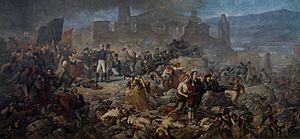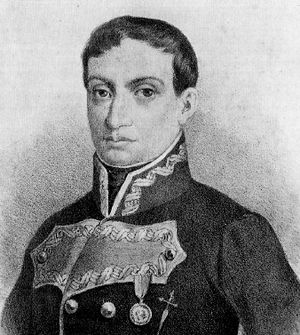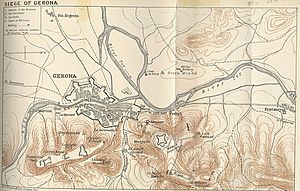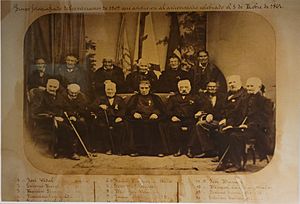Third siege of Girona facts for kids
Quick facts for kids Siege of Girona |
|||||||
|---|---|---|---|---|---|---|---|
| Part of the Peninsular War | |||||||
|
|||||||
| Belligerents | |||||||
| Commanders and leaders | |||||||
| Strength | |||||||
| 17,000 siege regulars 15,000 covering army |
5,700 regulars and militia 3,600 reinforcements 1100 citizens and clerics |
||||||
| Casualties and losses | |||||||
| 14,000 dead, wounded, or ill | 5,000 dead 1,200 wounded 3,000 captured |
||||||
The third siege of Girona was a long and difficult battle that happened in northern Catalonia, Spain. It took place from May 6 to December 12, 1809, during the Napoleonic Wars. This event was a big part of the Peninsular War. France's large army, called the Grande Armée, surrounded the town of Girona for seven months. Girona was very important because it was on the main road connecting France and Spain.
About 32,000 French and Westphalian soldiers attacked the town. General Laurent de Gouvion Saint-Cyr led the French for most of the siege. Later, Marshal Pierre Augereau took over command. Girona's defense was led by General Mariano Álvarez de Castro. He had about 9,000 regular soldiers and local fighters. Girona managed to hold out for a long time. But eventually, sickness and hunger forced the city to give up.
Even though they were greatly outnumbered, the Spanish defenders made the siege last a long time. This kept a large French army busy for an entire fighting season. This battle became famous in Spain's War of Independence. General Álvarez became a national hero for his bravery.
Contents
Why Was Girona Important?
In 1808, Joseph Bonaparte became the king of Spain. This meant Spain was largely controlled by Napoleonic France. Many Spanish people did not like this, and their resistance started the Peninsular War (1808-1814).
General Álvarez was in charge of Montjuïc Castle in Barcelona. His leaders told him to give up the castle to the French. But Álvarez had been getting ready to fight. He left Barcelona and joined the Spanish rebels who were fighting against French rule.
The Spanish Government in Cadiz made him the commander of the Army of Catalonia. He also became the Governor of Girona. The city of Girona was very important because it was on the main road between France and Spain. The French had tried to capture Girona twice before. They attacked in June 1808 during the Battle of Girona (1808). Then they tried again for three weeks in July and August during the Second siege of Girona. Both times, the French had to leave without taking the city. The French had captured the nearby city of Roses and its fort in late 1808.
Preparing for Battle
General Álvarez took command of Girona on February 1, 1809. He immediately started getting the city ready for defense. He asked for enough food and supplies for 7,000 men. At that time, Girona had about 13,000 to 14,000 people living there. The city was defended by about 5,700 soldiers. Some of these defenders were Irish soldiers from the Ultonia Regiment.
The women of Girona also helped a lot. They formed a group called the Company of Santa Barbara. They cared for the sick and wounded. They also carried ammunition and did other important jobs. On April 1, Álvarez made a famous rule. He said that if anyone talked about surrendering the city, they would be immediately executed. On May 3, weapons were given to 1,717 volunteers.
The walls and forts of Girona were old. They had not been updated in a hundred years. The medieval walls were thin and could not hold many cannons. One area, Mercadal, was especially weak. However, the French did not attack there. They were worried about cannon fire from Girona's higher ground. They also remembered how hard street fighting was in the second siege of Zaragoza. Also, digging trenches in Mercadal would have been difficult because of floods from the River Ter. The city's defenses were made stronger by other forts and small strongholds on the mountain behind Girona. Even though Montjuïc Castle had many cannons, fewer than 300 men knew how to use them well. Still, Álvarez used all the defenses as best he could.
How the Siege Unfolded
In early May 1809, General Saint-Cyr began setting up his cannons and forts. He had 40 gun batteries ready. The French army had over 17,000 men attacking the city. This group was led by General Jean-Antoine Verdier. Another 15,000 men, led by Saint-Cyr, formed a "covering army." Their job was to protect and support the main attacking force.
On June 12, Álvarez refused a peace offer from the French. Saint-Cyr then ordered the attack to begin after midnight on June 13-14. For the next seven months, the French fired many bombs, grenades, and cannonballs into the city. They also attacked the nearby Montjuïc Castle.
After three weeks of heavy bombing, the French tried to take Montjuïc Castle on July 7. Verdier sent 2,500 men to attack. Even though the castle's cannons were quiet, the French lost over a thousand men from constant musket fire. They had to retreat. The French then continued bombing the fort, destroying three sides of the castle.
With little water left, and the French digging closer to the castle, the remaining defenders left the castle on August 11. They took what supplies they could and went to Girona. They blew up the castle as they left. Álvarez then built barricades and trenches inside Girona. The siege continued for four more months. General Joaquín Blake tried to send help to the city, but his efforts were not very successful. Only about 3,600 extra troops managed to get into Girona during the siege.

The French had planned to take Montjuïc, expecting Girona to surrender quickly after. But in September, the Spanish again refused to surrender. The French then launched their first direct attack on the city on September 19. The constant bombing had created several holes in the city's northern walls. After fierce hand-to-hand fighting, the Spanish fought back many attacks. The French finally gave up and retreated. The French lost 624 soldiers in this attack, while the Spanish lost 251. This event made the French feel discouraged and gave the Spanish more hope.
Towards the end of September, General Saint-Cyr left his command. He was angry because he was being replaced as the leader of the French forces. He left the troops without a commander for several days, which was against his orders. Marshal Augereau took over the siege on October 12. After the bloody battles in August and September, the French changed their plan. They decided to wait and try to force Girona to surrender through hunger and disease.
In December, Álvarez became very sick and confused. He gave command to Brigadier Juan Bolivar. The French had taken several important forts in the city. The Spanish were retreating inside the city itself. Two days later, on December 12, the town finally surrendered. It is thought that about 10,000 Spanish soldiers and civilians died during the siege. Most died from sickness or hunger. Only about 8,000 of the original 14,000 people in the city survived. About 3,000 very weak soldiers were left to surrender. The French lost about 14,000 soldiers, with more than half dying from disease.
What Happened Next?
After seven months of fighting and heavy bombing, Girona was almost completely destroyed. There was little left of value for the French. As writer Charles Oman described it, Girona looked like a sad place. Houses had no roofs, or their walls were broken. Streets were blocked by fallen stones from churches and towers. Half-buried bodies were under the rubble. The open areas were covered with broken guns, bloody clothes, and parts of cannons. The smell was so terrible that Augereau had to keep his troops out of the city to prevent them from getting sick.
Even though Álvarez was very sick, the French put him and the other officers from Girona in prison in Perpignan, France, on December 23. After a month, he was taken to face a trial for treason at the Sant Ferran Castle in Figueres. On January 21, 1810, the day after he arrived at the castle, Álvarez was found dead in his cell.
Despite the French victory, Girona's long resistance was important for Spain. The siege kept a large French army busy for an entire fighting season. This battle became a legend in Spain's War of Independence. It helped to inspire national resistance, and Álvarez became a national hero.
See also
 In Spanish: Sitio de Gerona (1809) para niños
In Spanish: Sitio de Gerona (1809) para niños
- A History of the Peninsular War
- Battle of Gerona (1808)
- Second siege of Gerona (1808)




